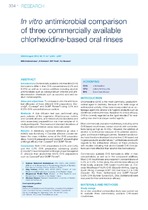In vitro antimicrobial comparison of three commercially available chlorhexidine-based oral rinses

View/
Date
2016Author
Abdalrahman, Basheer Mohamed
Holmes, Haly
Peck, Mogammad T.
Basson, Nicolaas
Metadata
Show full item recordAbstract
INTRODUCTION: Commercially available chlorhexidine (CHX)
formulations differ in their CHX concentrations (0.2% and
0.12%) as well as in various additives including alcohol,
antimicrobials such as cetylpyridinium chloride and antidiscolouration
chemicals such as ascorbic acid and sodium
metabisulphite.
AIMS AND OBJECTIVES: To compare in vitro the antimicrobial
efficacies of three different CHX preparations (Corsodyl
®, Curasept® and GUM® Paroex®) using 0.2% and
0.12% CHX concentrations as controls
METHODS: A disk diffusion test was performed using
pure cultures of the organisms Streptococcus mutans
and Candida albicans, and mixed cultures (facultative and
strict anaerobes) prepared from oral rinse samples of 14
study participants. The means and standard deviations of
the diameters of inhibition zones were calculated.
RESULTS: A statistically significant difference (p value =
0.0001) was found only in Candida albicans cultures between
the mean inhibition zones of the CHX preparation
disks. Pure CHX preparations and Corsodyl® showed higher
antifungal efficacy than Curasept® and GUM® Paroex
Conclusion: Both CHX preparations (0.12% and 0.2%)
and the 0.2% CHX preparation containing alcohol
(Corsodyl®) have more potent antifungal properties against
C. albicans than alcohol-free 0.12% CHX preparations
such as Curasept® and GUM® Paroex®.
